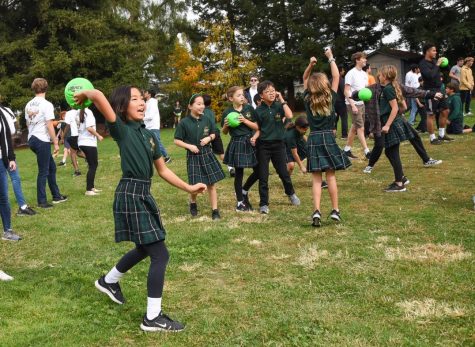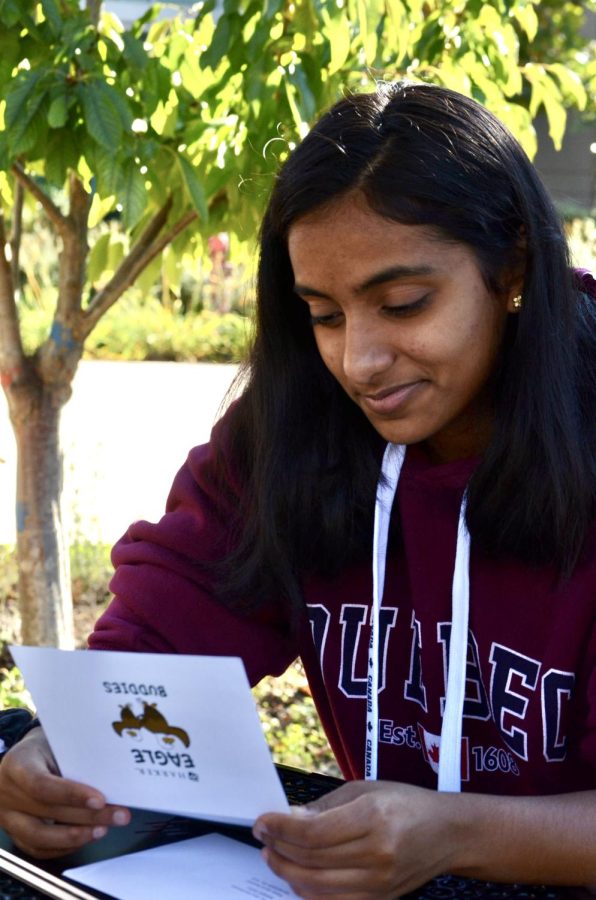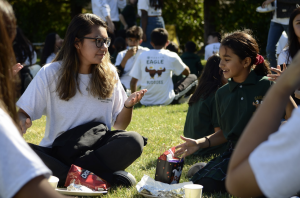Across campus and age differences: Eagle Buddy program unites Harker community
Diya Mukherjee (10) reads a note from her Eagle Buddy during lunch at the upper school on Nov. 12. The cards, written by third graders in response to notes sophomores had sent two weeks prior, were delivered to sophomores that morning after a LIFE session.
December 8, 2021
Heated discussions vying for possession of colored pencils and markers crowded the air of many classrooms during a special Oct. 20 hour-long advisory period. During this time, the sophomore class took their first steps in a cherished Harker tradition—the Eagle Buddy program. After receiving two assigned third-grade buddies, the sophomores wrote letters to the younger students on cards emblazoned with a stylized cartoon of a smiling eagle.
After decorating the cards with smiley-face doodles and stickers of their student portraits, the sophomores used the much-contested art supplies to color bright images, like beaches and gardens, onto blank puzzles that they broke into pieces and placed in manila envelopes for their buddies to reconstruct.
The letters they received back took the form of notes in lopsided, eight-year-old handwriting or of QR codes to short Flipgrid videos, which the juniors and seniors have also been using to interact with their buddies virtually during quarantine.
The Eagle Buddy system has been in effect for over 10 years and was introduced by Butch and Jane Keller, respectively the head of the upper school and an upper school math teacher, who adapted the idea from a private school they previously taught at. The program’s process for matching upper and lower school students was arbitrary until two years ago, when upper school students developed a computer program that made matches by prioritizing shared interests.
At the beginning of the school year, students filled out a form asking a single question: how would you spend one hour of free time? Options included reading, playing sports and arts and crafts. The algorithm could then use these answers to create groups of three to four high schoolers and two to three younger students.
“For the current fifth grade, [the matching process] was a little bit different,” Mary Holaday, the lower school Dean of Students, said. “It was more of a random grouping; we tried to do more boys with boys and girls with girls, but [for current third and fourth graders] we knew that it was important that we have a good mixture and a good balance of people together.”
Sophomores customarily meet their buddies in person for the first time in October, but for the past two years, COVID-19 social distancing protocols, along with concerns about vaccination rates among the younger buddies, have prevented in-person interaction.
Instead, sophomores received a more mellow work session to create notes and puzzles for their buddies. Jasmine Ishikawa (10) drew scenes from her favorite childhood movie growing up, ‘Spirited Away,’ on the puzzles for her buddies. In exchanging letters with her buddies, she was able to find common interests from her childhood.
“I was glad to see that they’re reading some of the books that I read as a kid, like ‘Harry Potter,’” Jasmine said. “I thought this was a really good opportunity to meet with other kids and see what younger kids are doing, which I’m glad about because I don’t have any younger siblings.”
Saahil Kajarekar (10) put care into writing thoughtful and helpful letters to his buddies.
“The process has made me a little more reflective of myself and how I can guide them and myself throughout the future,” Saahil said. In tandem, he did try to inject some humor by adding in his favorite quotes: “Famous people can speak better than I can.”

Holaday described her observations in past years of the lower school side of the program’s excitement over gifts and visits from their older buddies.
“You can see the smiles on the kids’ faces, you can see the smile on the homeroom teacher’s faces,” Holaday said. “The kids love the puzzles from the upper school kids; they have taken them out at recess time and tried to put them all together. I like that feeling of bringing everybody together and seeing everybody so happy.”
Jonathan Rim, who used to work at the lower school and now serves as interim head of the Eagle Buddy program at the upper school during Ms. Keller’s leave, has similar fond memories watching third-graders receive their first Eagle Buddy messages.
“It’s really cute to me that they get super excited,” Rim said. “Part of the reason why I stepped up [as upper school head for Eagle Buddies] is seeing that connection between the lower school students and upper school students. For the lower school, they’re having some sort of mentor, and for the older student, [being] a role model is a good experience as well.”
In their sophomore year, current seniors visited the lower school campus to play sports and eat lunch with their buddies, making them the last grade to experience the program’s in-person activities. According to senior Justin Fung, his relationship with his buddy has grown from that of a formal, and initially awkward, mentoring situation into an organic friendship.
“I did try to be a mentor, show him around and take care of him, but I found that the more you hang out with them, you can bond a lot,” Justin said. “The mentees at some point just become someone that you’re hanging out with.”
Justin strengthened his relationship with his Eagle Buddy by encouraging his interests, and he felt pleased to watch his Eagle Buddy’s sense of self evolve in the letters and Flipgrid videos they exchanged during quarantine.
“The kids think upper school students are stars, so what’s nice is that you can help get them interested in things that you’re interested in, like in my case, Quiz Bowl,” Justin said. “You can pass on things that you picked up in a nice way. My buddy’s definitely grown; I can tell in his letters that he’s thinking more about the future, being more reflective. It’s good to see how little kids are growing just like we’re growing.”
To Rim, the Eagle Buddy program symbolizes a larger value of connection and celebrating the surprising interests that Harker students of any age may share. While videos and letters have worked well in maintaining strong exchanges between buddies in quarantine, he looks forward to when in-person meetings will be possible.
“Because we’re spread out on different campuses, and sometimes it’s harder to see that connection between us all. Participating in this program is one way to connect and be a Harker family,” Rim said. “The vaccination rate at the lower school is coming along, and I’m hoping that we will eventually get to see each other, maybe even by this spring.”


















![“[Building nerf blasters] became this outlet of creativity for me that hasn't been matched by anything else. The process [of] making a build complete to your desire is such a painstakingly difficult process, but I've had to learn from [the skills needed from] soldering to proper painting. There's so many different options for everything, if you think about it, it exists. The best part is [that] if it doesn't exist, you can build it yourself," Ishaan Parate said.](https://harkeraquila.com/wp-content/uploads/2022/08/DSC_8149-900x604.jpg)




![“When I came into high school, I was ready to be a follower. But DECA was a game changer for me. It helped me overcome my fear of public speaking, and it's played such a major role in who I've become today. To be able to successfully lead a chapter of 150 students, an officer team and be one of the upperclassmen I once really admired is something I'm [really] proud of,” Anvitha Tummala ('21) said.](https://harkeraquila.com/wp-content/uploads/2021/07/Screen-Shot-2021-07-25-at-9.50.05-AM-900x594.png)







![“I think getting up in the morning and having a sense of purpose [is exciting]. I think without a certain amount of drive, life is kind of obsolete and mundane, and I think having that every single day is what makes each day unique and kind of makes life exciting,” Neymika Jain (12) said.](https://harkeraquila.com/wp-content/uploads/2017/06/Screen-Shot-2017-06-03-at-4.54.16-PM.png)








![“My slogan is ‘slow feet, don’t eat, and I’m hungry.’ You need to run fast to get where you are–you aren't going to get those championships if you aren't fast,” Angel Cervantes (12) said. “I want to do well in school on my tests and in track and win championships for my team. I live by that, [and] I can do that anywhere: in the classroom or on the field.”](https://harkeraquila.com/wp-content/uploads/2018/06/DSC5146-900x601.jpg)
![“[Volleyball has] taught me how to fall correctly, and another thing it taught is that you don’t have to be the best at something to be good at it. If you just hit the ball in a smart way, then it still scores points and you’re good at it. You could be a background player and still make a much bigger impact on the team than you would think,” Anya Gert (’20) said.](https://harkeraquila.com/wp-content/uploads/2020/06/AnnaGert_JinTuan_HoHPhotoEdited-600x900.jpeg)

![“I'm not nearly there yet, but [my confidence has] definitely been getting better since I was pretty shy and timid coming into Harker my freshman year. I know that there's a lot of people that are really confident in what they do, and I really admire them. Everyone's so driven and that has really pushed me to kind of try to find my own place in high school and be more confident,” Alyssa Huang (’20) said.](https://harkeraquila.com/wp-content/uploads/2020/06/AlyssaHuang_EmilyChen_HoHPhoto-900x749.jpeg)








